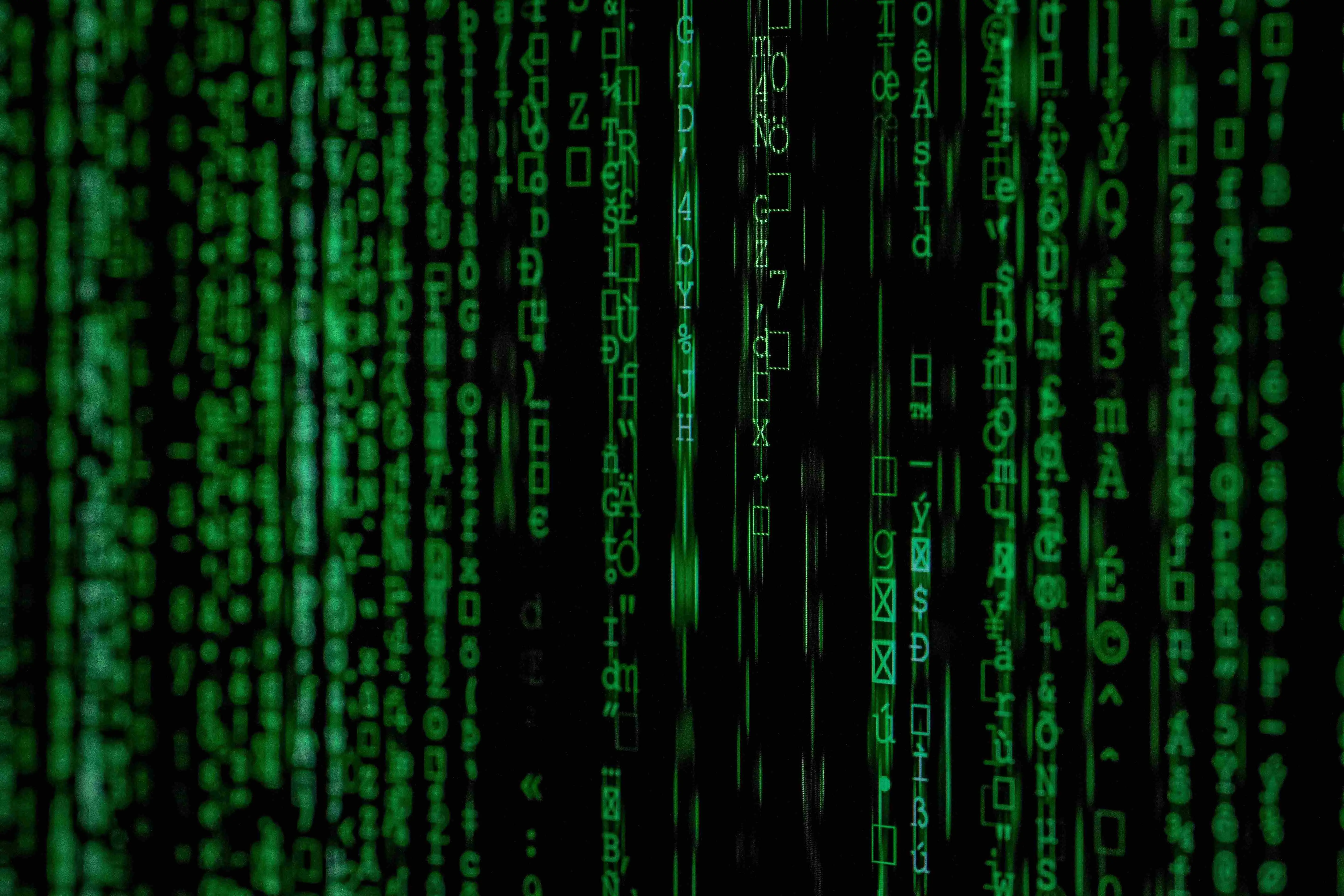AI new dark horse, is KIP Protocol the next early "Bittensor"?
Author: Mia, ChainCatcher
With the emergence of OpenAI's video generation model Sora and Google's MoE architecture-based Gemini 1.5 Pro large model, there has been a heated response in the global market.
However, the strong rise of AI giants like OpenAI and Google has also raised public concerns about data privacy and security issues. How to ensure the digital property rights of creators while continuously enhancing the deep learning capabilities of AI is a question that needs to be considered.
Thus, KIP Protocol, the first decentralized Web3 underlying protocol focused on AI, was born.
KIP Protocol: A Web3 Underlying Protocol Focused on AI Security Innovation
At the beginning of 2024, a16z included "AI + Crypto" in its "2024 Outlook List," emphasizing that cryptographic technology can "create multilateral, global, permissionless markets where anyone can contribute computing power or new datasets for a network need and be compensated," and that the long tail of utilizing these resources will lower the cost of AI and make data more accessible.
Vitalik Buterin also envisioned "AI + Crypto" in his article, believing that cryptographic technology can balance the centralization and transparency of AI and help optimize AI data storage.
The goal of KIP Protocol is to develop a secure and efficient decentralized Web3 underlying protocol that enables AI creators (data owners, model makers, AI application developers) to:
- Deploy their work on Web3, thus retaining complete digital property rights
- Interact and trade with other AI assets
- Generate revenue without losing access control
At the same time, KIP Protocol is also the world's first Web3 protocol to support decentralized RAG (Retrieval-Augmented Generation) solutions. The second article in its official Explainer series highlights the concept of RAG.
RAG is a complex innovative technology used in generative AI that allows AI models to generate answers they originally did not know by retrieving data and information from external knowledge bases and databases. It acts like a smart assistant that, while not knowing the answer to your question, can professionally find the answer you want from external data to protect data security without exposing it to the model.
RAG technology involves three key value creators in AI (App developers, model makers, and data owners).
By establishing a decentralized RAG framework, KIP essentially creates a framework for decentralized control of AI value creation, providing a fair competitive environment for all value creators, thus breaking free from AI monopolies. At the same time, it allows AI to function efficiently, becoming a product of the joint efforts of millions of small and large creators without any single large company controlling every core function.
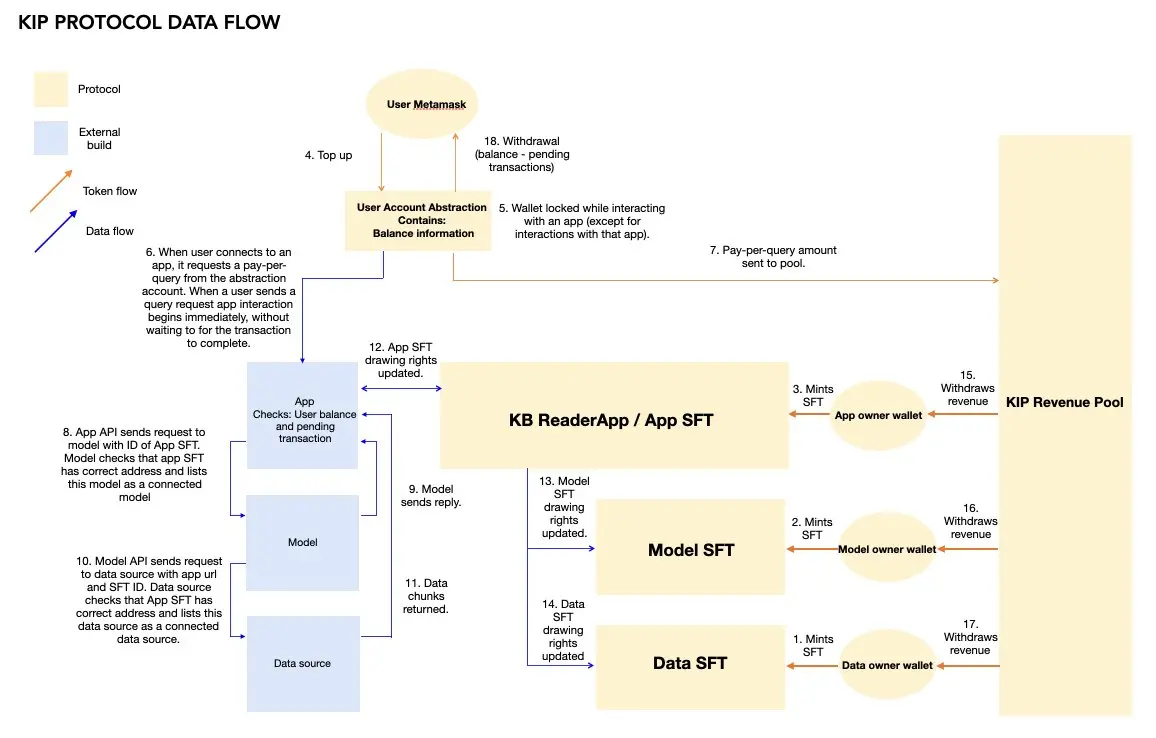
Recently, KIP Protocol announced a strategic round of financing led by Animoca Ventures. According to the official introduction, the KIP team consists of senior PhDs and technical experts dedicated to AI research since 2019, who also have a strong professional background and rich experience in the Web3 field.
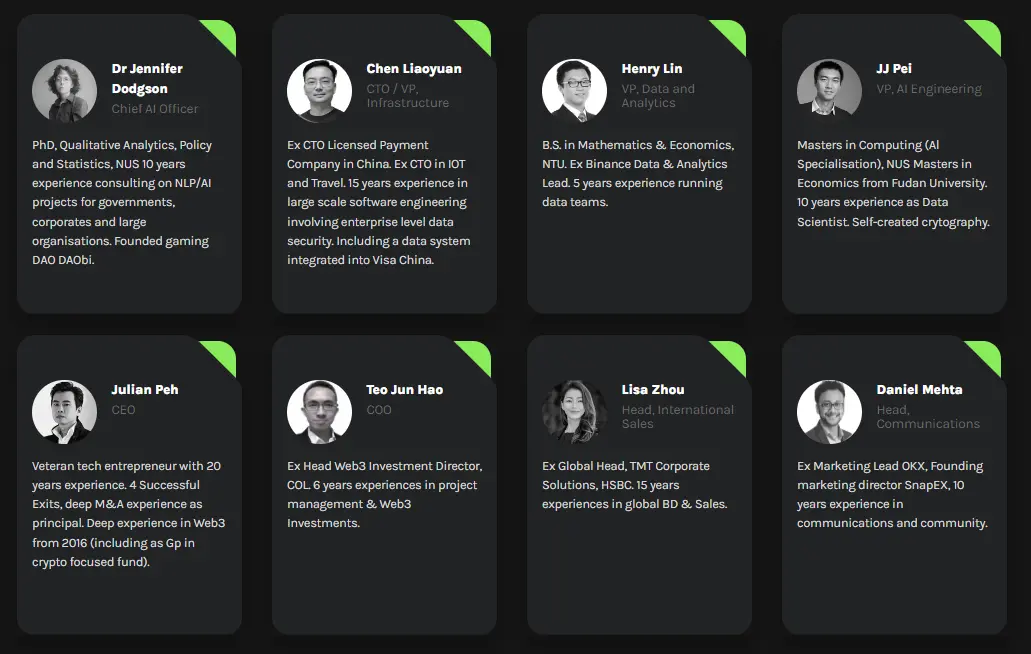
At the same time, the KIP Protocol team won the Tencent Cloud Award at the 2023 Chainlink Constellation Hackathon. The first app on its protocol, "Kipley.ai," a security-focused multi-model RAG platform, has successfully collaborated with ++Animoca Ventures++, ++Thailand Institute of Scientific and Technological Research++, ++Anomaly++, and many professors and researchers from well-known universities. The first dapp on the protocol, "KnowledgeFi," is also set to launch in the first or second quarter of 2024, according to its white paper.
Decentralization: The Inevitable Path for AI Towards the Future
In the AI era, data and information support the operation of AI, and the importance of data is self-evident; only by forming a sufficiently large dataset can algorithm models be trained, ultimately leading to economic effects. With the development of the AI field, the competition to build the largest and strongest models has begun, and "digital property monopolies" have become a focal point for major tech giants.
The original intention of building KIP Protocol is to protect the digital property rights of AI creators through Web3, providing a fair monetization path for every AI creator, establishing a diversified business ecosystem composed of different partners (data owners, model makers, AI application developers), and helping them achieve free collaboration or production creation based on KIP Protocol to break free from the growing AI monopoly of tech giants.
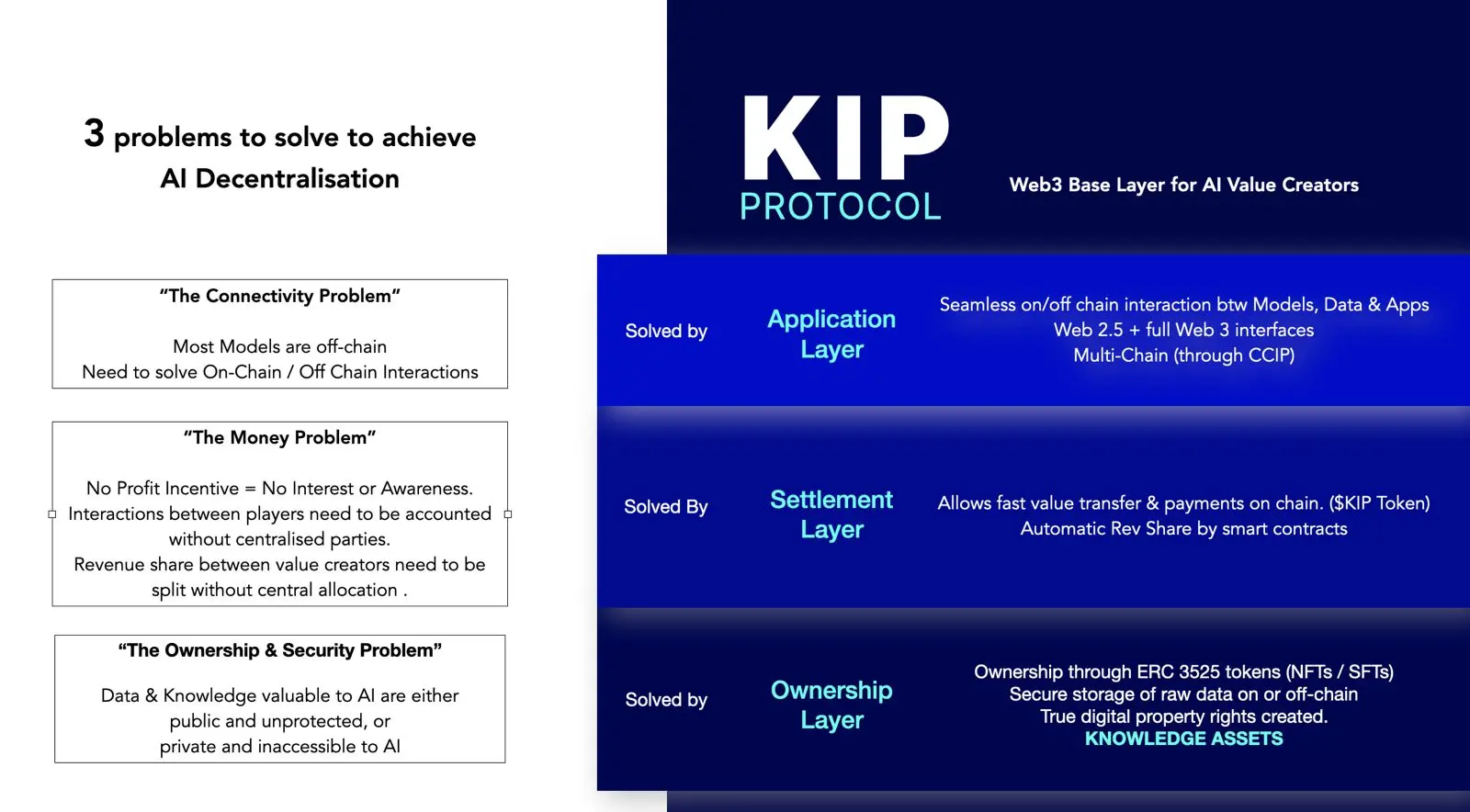
In this regard, KIP addresses three fundamental issues that AI model makers, App developers, and data owners face when attempting decentralization.
"On-chain and Off-chain Data Interoperability" Issue
With the continuous development of AI technology, the number of models on the open-source model library platform Hugging Face has exceeded 500,000. However, due to the current blockchain technology's inability to achieve complete decentralization, most AI models remain in the off-chain stage, while the application layer of KIP Protocol solves the interaction problem between on-chain and off-chain.
Through the application layer, KIP can easily upload different assets (such as software, data, etc.) to the chain. AI applications can mint ERC-3525 SFT based on KIP Protocol, freely integrate and seamlessly interact with AI models and data assets, and these interactions will be recorded on-chain through KIP Protocol. At the same time, AI application creators and users can choose which models, data, and application formats to use based on their needs.
"Revenue Monetization" Issue
Currently, the basic revenue model in the AI field is pay-per-query, as each user query consumes GPU computing power. Moreover, answering a user's query requires multiple AI value creators to respond to the question.
Therefore, for KIP Protocol, which is committed to decentralizing AI, to succeed, it must ensure that all parties involved in decentralizing AI work can generate revenue.
However, this is not a simple task in the AI field. For example, running queries through RAG (Retrieval-Augmented Generation):
- The user asks a question to the AI chatbot.
- The AI chatbot forwards the query to its brain—the AI model.
- The model retrieves relevant data blocks from the knowledge base needed to answer the question, formulates an answer, and sends it back to the app.
- The app packages the answer and sends it to the user.
In this example, you can see how the three roles contribute to answering the user's query.
In a centralized ecosystem, if one platform owns and controls all three roles, the user only needs to pay this centralized platform, and the rest are internal transfers.
But if KIP Protocol wants to decentralize rather than monopolize, then each party needs to be paid, thus requiring solutions to the following issues:
- Record (on-chain) everyone's contributions
- Distribute user revenue
- Ensure everyone can earn their own income
Based on KIP Protocol, each creator can set their own price for the query function, and KIP will ensure that the fees paid by users are proportionally distributed to AI value creators (model makers, App developers, data owners).
Since every interaction is recorded on-chain, KIP can conduct accurate AI interactions and revenue accounting through a low Gas, high-efficiency settlement layer, allowing each creator to earn a corresponding proportion of rewards while contributing to digital property rights.
"Digital Property Rights Protection" Issue
KIP Protocol uses blockchain tokens, particularly in the form of ERC-3525 tokens (SFT), to store different assets (such as software, data, etc.) in the property layer of the KIP Protocol framework.
For data owners: SFT represents a vectorized knowledge base or links to encrypted raw data files used for model training.
For model makers: SFT can represent an API to off-chain models or a set of weight models available for sale.
For App developers: SFT can represent the front-end API or the prompts themselves.
These SFTs act as "monetization entities" that can interact with each other on-chain and record the amount earned from specific transactions for each SFT.
By addressing these issues, KIP can enable AI value creators to easily achieve decentralization in their work, creating initial conditions for a vibrant and larger decentralized AI ecosystem.
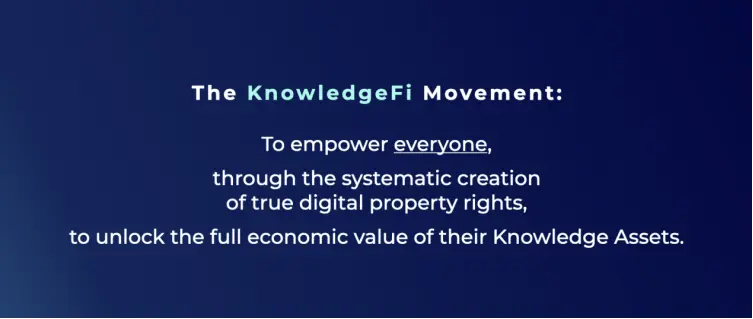
KIP Cycle in Progress, Overseas KOLs Support KIP's New Concept
Currently, KIP has launched multiple cycle activities on the X platform, with the 10th activity just concluded. Users need to unlock and complete corresponding tasks on Galxe to earn project points.
When it comes to points, it inevitably reminds us of the recent popularity of "point-based fair launches." Additionally, according to the KIP white paper regarding the $KIP token economics, it was mentioned that 35% of the total supply would be allocated to the ecosystem fund, which includes community rewards primarily based on "loyalty." Therefore, it is reasonable to believe that the so-called "airdrop expectations" are not unfounded. Moreover, without large-scale market promotion, the total number of participants in the KIP Cycle has exceeded 50k, indicating that the KIP project has considerable popularity overseas.

In fact, KIP has now become a hot Alpha project among crypto investors focused on the AI sector.
Well-known BTC investment KOL Marco Johanning stated on the X platform, "KIP is the first Web3 underlying protocol supporting decentralized AI RAG, and the project is still in its early stages." He also mentioned that he has contacted the KIP team, "The KIP team has only reached out to some early investors of Bittensor, as $TAO Holders have not sold but share a common expectation for the AI sector."
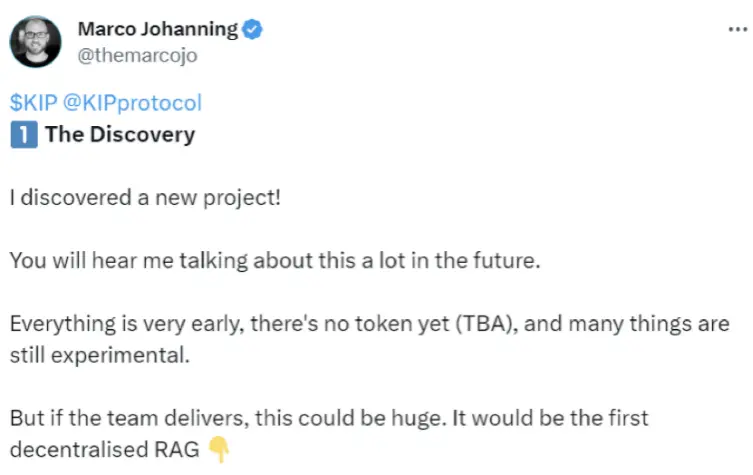
Meanwhile, crypto KOL AI Project Hub, deeply engaged in the AI sector, described "KIP Protocol" as "a different approach to decentralized AI research, which complements Bittensor (a protocol for decentralized incentivized machine learning intelligent production)."
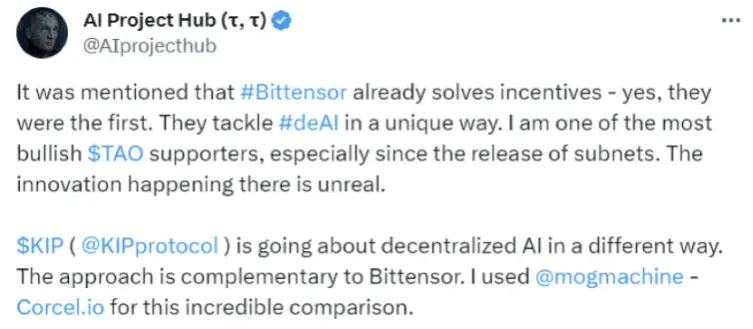
In response, another overseas influencer, Crypto Phoenix, commented on this article with an open attitude, stating that after researching relevant materials, he believes the launch of the KIP project has been well thought out, "especially regarding the realization period and growth plan," and clearly indicated that KIP may achieve great success in the future.

Additionally, crypto influencer @wauwda, with nearly 50,000 followers, has also extended an olive branch to the KIP project, publicly stating that he participated in KIP's early financing.

Notably, well-known crypto blogger Tomb has listed KIP as the next potential wealth code.
Currently, overseas crypto investors in the AI sector are racing to be the "first to take the plunge." However, compared to the excitement and activity in overseas markets, KIP's influence and recognition in the Chinese-speaking market are still in a relatively blank period, which also means that KIP holds infinite possibilities and opportunities for Chinese-speaking investors.
From the exchanges with the aforementioned KOLs and the team, we can deeply feel that this is a mature and visionary team, not only having a clear and definite plan for the development of KIP Protocol but also being full of confidence and expectations for the future. This confidence and expectation are not unfounded but are based on their profound understanding of AI and blockchain technology and solid technical strength.
In the eyes of the KIP team, the choice of early users is crucial; they prefer to seek "long-term holders with an AI vision." Such a user group can not only bring stable and lasting support to the community but also form a strong consensus with the team to jointly promote the development of KIP Protocol.
Summary
If "Crypto + AI = future of finance," then KIP may be a powerful bet at the intersection of AI and crypto.
So far, in the "Crypto + AI" field, KIP is the first decentralized underlying protocol focused on AI. As an open-source Web3 underlying protocol, KIP Protocol always adheres to the value concept of "In the AI era, everyone should achieve KnowledgeFi," promoting the creation, management, and monetization of decentralized digital property rights to realize KnowledgeFi. Recently, KIP Protocol announced its successful entry into Google's Cloud Startups Program, and the Dapp KnowledgeFi is set to launch in the first or second quarter of this year.
I believe that "Crypto + AI" is still a blue ocean market with enormous potential, and paying attention to the development of early infrastructure is the first step to embracing the new wave. Although KIP's future path is still long, the value concept and vision of KIP are spreading from overseas communities to the world.
About KIP Protocol
KIP Protocol builds a Web3 underlying protocol for AI App developers, model makers, and data owners, enabling AI assets to be easily deployed and monetized while retaining complete digital property rights.
KIP will establish a new AI business ecosystem to address the issues and challenges faced in decentralized AI deployment and ensure that everyone can enjoy the economic benefits brought by AI.
The KIP team consists of senior PhDs and technical experts dedicated to AI research since 2019, who also have a strong professional background and rich experience in the Web3 field, committed to promoting AI decentralization and becoming an accelerating catalyst for the decentralized AI wave.
To learn more, please visit ++www.kip.pro++ or follow them on X ++@KIPProtocol++.







